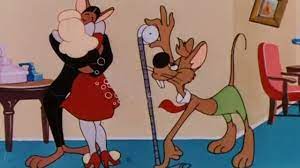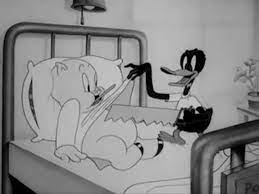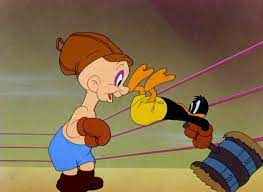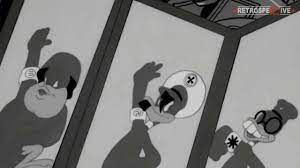“No time like the present.”

Directed by Arthur Davis; Animation by J.C. Melendez, Don Williams, Emery Hawkins, and Basil Davidovich; Story by Lloyd Turner and William Scott; Layouts by Don Smith; Backgrounds by Philip DeGuard; Voice Characterization by Mel Blanc; Musical Direction by Carl W. Stalling. A Merrie Melody released on December 27, 1948.
This post would not have been possible without contributions from readers like Carl Hunt. Thank You.
Elmo Mouse will be our titular “hick” this evening. He’s in a good mood as he’s off to visit the resident chick, Daisy Lou. Upon arriving at her place, he thinks he’s made a mistake of addresses as the doe inside is busy making out with someone who isn’t Elmo. Sadly, he’s at the right house. Her make out partner was the third part of our puzzle, Blackie the prick. The two at least have the decency to take a breath now that they’ve got company, and to be fair D.L. is polite enough to let both guys stay. Oh, yeah. I meant “slick” earlier. Honest mistake.
Elmo has some (mouse-scale) flowers and Daisy does seem happy to receive them, even if Blackie already bought out a florist shop for her. Elmo’s flowers are so embarrassed, they regress back into seeds. Elmo tries to play her a song on his mouth organ, but Blackie can play piano. Particularly, a familiar piano piece that leads me to believe Blackie’s father was the mouse in “Rhapsody Rabbit“. About the only other good trait Elmo has is muscles and to his credit, I agree that Blackie could not make his arm go limp like that. His biceps look too healthy. Feel healthy too, seeing as they knock Elmo out of the house.
When Elmo returns, he finds Uncle Blackie (as I think I’m allowed to call him) presenting Ms. Lou with a fur coat. Elmo isn’t impressed like she is, claiming that he could get her something better. As Uncle B. points out, the only thing that feasibly could be better is ermine. Elmo agrees but it’s only once he’s out of the hole that he reveals he’s dug himself into another; he doesn’t know what an ermine even is.
Searching the premises, he looks in a bottle of champagne which really doesn’t help much. What it does do is remove his common sense. Most creatures his size would try to avoid creatures like the dozing cat in the house, but he’s actually approaching. It might have something to do with the fact that the cat’s name is Merman, but he can only see the last five-sixth’s of the word. And yes, the cat’s name probably really is ‘Herman’ but it doesn’t look like it at first glance! (Does this mean Blackie’s real first name is ‘Katnip’? No wonder he changed it.)
The cat isn’t fazed by the punch drunk rodent, and tries to eat him. Elmo escapes and falls into the milk bowl, which is good news since milk is nature’s natural sobering agent. He flees, and the cat chases, taking a swing at him as he runs on a table. This makes the leaf smack him in the face, knocking himself out but good. Well, well. Just look at all that fur just practically begging to be taken! Good thing Elmo’s a furrier! He presents the goods to Daisy and he totally wins. She’s got no problem being a trophy, because she gets things out of it. What a good moral.
Hick and Chick leave together, leaving the Slick to wonder where he managed to get the stuff. The cat tells him to mind his own business, showing us Elmo used his @$$ hair to make the coat. (Why to the you to the sea and kay.) Even the iris-out is coat shaped. And when you get pancakes tomorrow, they’ll probably be coat shaped too.
Favorite Part: Jealousy running rampant in Elmo’s mind, he imagines certain instances of bad luck Blackie could befall. Like Elmo mounting his head over a fireplace.
Personal Rating: 3








 Directed by Arthur Davis; Story by Lloyd Turner, William Scott; Animation by J.C. Melendez, Don Williams, Emery Hawkins, and Basil Davidovich; Layouts by Don Smith; Backgrounds by Phlip DeGuard; Voice Characterization by Mel Blanc; Musical Direction by Carl W. Stalling. Released in 1948
Directed by Arthur Davis; Story by Lloyd Turner, William Scott; Animation by J.C. Melendez, Don Williams, Emery Hawkins, and Basil Davidovich; Layouts by Don Smith; Backgrounds by Phlip DeGuard; Voice Characterization by Mel Blanc; Musical Direction by Carl W. Stalling. Released in 1948